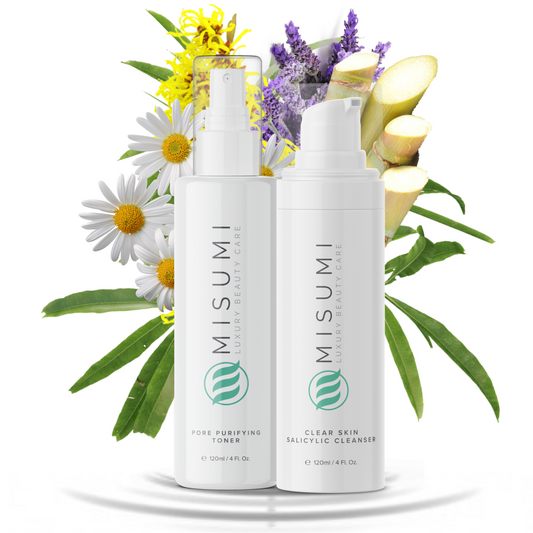Acne redness on the face isn't just about visible pimples or clogged pores. It's about the persistent redness, the inflammation, the irritation, and the detrimental effect it can have on your confidence. But don't worry, getting rid of redness from acne is no longer an elusive quest. Here, we'll share tried and tested dermatologist-approved methods to reduce acne redness and regain your glowing complexion.
Understanding Acne Redness
First, let's get to the root of the issue. What causes acne redness? Simply put, when your skin's pores get clogged with excess oils and dead skin cells, it paves the way for bacterial growth, resulting in inflamed pimples. This inflammation is what gives acne its characteristic redness.
Now, how do we reduce this acne redness?
Topical Agents: The Frontline Warriors
Using topical agents specially designed to combat acne can be your first step in reducing acne redness. Salicylic acid and benzoyl peroxide are popular choices in this realm. Salicylic acid is a great peeling agent, which helps in removing dead skin cells and unclogging pores, while benzoyl peroxide is potent against acne-causing bacteria.
But remember, more isn't always better. Going overboard with these potent ingredients can lead to skin irritation. So, it's all about moderation.
A product that we swear by at Misumi Skincare is our niacinamide serum. Niacinamide is hailed for its anti-inflammatory properties and its ability to strengthen the skin barrier. It can work wonders in soothing inflammation and reducing acne redness.
No Picking or Squeezing Pimples
It can be tempting to squeeze or pick at your acne, especially when you spot a ripe whitehead. But hold back. Doing this can lead to trauma to the surrounding skin, increasing inflammation, and hence, redness. In worst-case scenarios, it can even lead to permanent scarring or post-inflammatory hyperpigmentation – a condition where dark spots remain long after the acne has healed.
Adopt a Simplicity-First Approach

Remember the age-old adage, "keep it simple, silly"? Well, it applies to skincare, too. Instead of bombarding your skin with a plethora of products, aim for a simple, gentle regimen. Choose a gentle cleanser that effectively removes excess oils without stripping your skin dry. And don't forget to hydrate your skin. Even if you have acne-prone skin, maintaining your skin's moisture balance is crucial.
Call in the Professionals: Dermatologists

Sometimes, despite our best efforts, acne redness doesn't budge. If you find yourself in this situation, don't despair. Consulting a board-certified dermatologist can help you get a tailored acne treatment that suits your skin type and condition.
Your dermatologist might prescribe topical retinoids, chemical peels, or even laser treatment. These treatments can cause a bit of redness as a side effect. But don't worry – that's just your skin getting used to the new regimen. Just remember to follow your dermatologist's instructions to a T.
Ice or a Cold Compress: Your Go-To Soothers
When acne becomes inflamed, applying ice or a cold compress can provide immediate relief. It helps reduce inflammation and thereby soothes redness. But remember, never apply ice directly onto your skin; always wrap it in a clean cloth first.
Be Mindful Of What Comes Into Contact With Your Face
Certain everyday items can harbor bacteria and oils, which when transferred onto your face, can exacerbate acne and redness. So, make sure to regularly clean things that frequently come into contact with your face – this includes your cell phone, makeup brushes, and pillowcases.
Protect Your Skin from the Sun
Sun exposure can exacerbate acne redness and even lead to dark spots. So, don't forget to apply a broad-spectrum sunscreen, regardless of whether you're stepping out or staying in. And remember, the sun's UV rays can penetrate through windows, so indoor sun protection is equally important.
Why Does Acne Redness Last Longer Than Actual Pimples?
Acne redness often sticks around longer than the pimple itself because it's a sign of skin inflammation. When your skin fights acne, blood vessels in the area expand to bring more blood, which can lead to persistent redness. Moreover, post-inflammatory hyperpigmentation, where the skin darkens at the site of inflammation, can make the area appear red even after the pimple has healed.
What Causes Acne Scarring?
Acne scarring is the result of significant skin inflammation. When a pimple swells, it can cause a break in the follicle wall. If the break is deep, it can damage surrounding tissue, leading to scars. Picking or squeezing pimples increases the risk of scarring as it leads to more inflammation and potential damage.
How Can I Reduce Redness from Acne Treatment?
Some acne treatments, such as retinoids, chemical peels, and laser treatments, can cause redness. To reduce this, always follow your dermatologist's instructions. Using a gentle cleanser, moisturizing your skin, and applying a cold compress can also help. Over-the-counter treatments with anti-inflammatory properties like aloe vera can soothe your skin, reducing redness.
Rosacea Breakouts = Redness

Rosacea is a skin condition that often leads to facial redness and can be mistaken for acne. However, unlike acne, rosacea doesn't lead to blackheads. It causes persistent redness, visible blood vessels, and red, bulbous nose. Acne treatments may not work for rosacea, and you may need specific rosacea treatments, which often include prescription medication.
How To Prevent Redness Caused By Acne?
Prevention is better than cure. To prevent redness caused by acne, follow a regular skincare regimen that includes gentle cleansing, effective moisturization, and sun protection. Regular exfoliation can also help prevent acne by removing dead skin cells and preventing clogged pores. Lastly, avoid squeezing pimples and stick to the 'hands-off' approach.
How To Exfoliate Acne-Prone Skin Without Causing Redness
Exfoliation is an essential step for acne-prone skin as it helps unclog pores. But harsh scrubs can irritate your skin, causing more redness. So, stick to gentle, chemical exfoliants like glycolic acid or salicylic acid. These dissolve dead skin cells without the need for physical scrubbing. Always follow up with a hydrating product to keep your skin balanced and happy.
How To Keep Acne Under Control with Misumi Clear Skin Duo Kit

Keeping acne under control can be a challenging task. But with the right products, it doesn't have to be. One such powerful combination that promises clear skin is Misumi's Clear Skin Duo Kit, composed of the AHA 10% Skin Perfecting Cleanser and the Pore Purifying Toner.
Let's delve into these products, their key ingredients, and how they work to keep your acne under control.
AHA 10% Skin Perfecting Cleanser

The first step in any effective acne-fighting routine is cleansing, and the Misumi AHA 10% Skin Perfecting Cleanser is a game-changer. AHA, or Alpha Hydroxy Acid, is its star ingredient. This powerful yet gentle exfoliant helps remove dead skin cells and unclog pores, thereby reducing acne breakouts.
The cleanser also includes other standout ingredients, such as:
Glycolic Acid
Glycolic Acid, a type of AHA derived from sugar cane, penetrates deeply into the skin to exfoliate and stimulate cell renewal. It can help to clear acne scars, reduce inflammation, and keep acne under control.
Salicylic Acid
Salicylic Acid, a Beta Hydroxy Acid (BHA), is another acne-fighting champion. It's oil-soluble, meaning it can penetrate into the pore lining and exfoliate inside the pores as well as on the skin surface.
Pore Purifying Toner

Next up in the Clear Skin Duo Kit is the Pore Purifying Toner. It's designed to further cleanse your skin post-washing, tighten enlarged pores, and balance skin pH levels. Here are the standout ingredients:
Witch Hazel
Witch Hazel is a natural astringent that helps reduce inflammation, decrease oil and redness, and alleviate irritation associated with acne.
Aloe Vera
Aloe Vera is renowned for its soothing properties. It can reduce inflammation and accelerate the healing process, making it a potent ingredient for acne-prone skin.
By using these two products in tandem, you can effectively manage your acne. Start with the AHA 10% Skin Perfecting Cleanser to gently exfoliate your skin, remove impurities, and unclog your pores. Follow it up with the Pore Purifying Toner to tighten your pores, balance your skin, and further soothe any inflammation.
And remember, while these products are designed to help you manage acne, it's also essential to maintain a healthy lifestyle. A balanced diet, regular exercise, sufficient hydration, and adequate sleep also play a critical role in keeping your skin clear and glowing.
Misumi's Clear Skin Duo Kit, when used consistently and correctly, can significantly help in keeping acne under control. However, everyone's skin is different, so results may vary. Always consult with a dermatologist if you're uncertain or if your condition doesn't improve or worsens.







